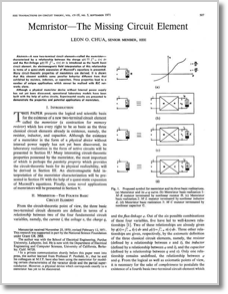

RESEARCH NEWS
Recognition — Leon Chua’s Memristor*
 My simple Google search for the keyword “memristor” today surprisingly resulted in nearly 80,000 items, many referring back to Leon Chua’s seminal paper “Memristor – The Missing Circuit Element” published in the IEEE Transactions on Circuits Theory (vol. 18, no. 5, pp. 507-519, September 1971). In that paper, Leon argued that in addition to the three well-known basic circuit elements, namely resistor, capacitor, and inductor, a fourth element should exist. He named this element the memristor, meaning the “memory resistor” because it can remember the current passing through it even after the current has disappeared. Is that a reality? On April 30, 2008, the Hewlett-Packard research team proudly announced their realization of a memristor prototype, with an official publication entitled “The Missing Memristor Found” in Nature (vol. 453, pp. 80-83, May 1, 2008).
My simple Google search for the keyword “memristor” today surprisingly resulted in nearly 80,000 items, many referring back to Leon Chua’s seminal paper “Memristor – The Missing Circuit Element” published in the IEEE Transactions on Circuits Theory (vol. 18, no. 5, pp. 507-519, September 1971). In that paper, Leon argued that in addition to the three well-known basic circuit elements, namely resistor, capacitor, and inductor, a fourth element should exist. He named this element the memristor, meaning the “memory resistor” because it can remember the current passing through it even after the current has disappeared. Is that a reality? On April 30, 2008, the Hewlett-Packard research team proudly announced their realization of a memristor prototype, with an official publication entitled “The Missing Memristor Found” in Nature (vol. 453, pp. 80-83, May 1, 2008).I am puzzled. Perhaps not only I, but everyone except Leon, believed that the set of three basic circuit elements are theoretically self-contained. How could Leon see a gap there so as to introduce the fourth element? Mathematically, there are five well-known relations among the four circuit quantities, charge q, current i, voltage v, and magnetic flux φ: two are fundamental physical laws, dq = idt and dφ = vdt, and three are basic circuit equations, dv = Rdi, dq = Cdv, and dφ = Ldi, where d is the differential operator, t is the time variable, and R, C, and L are resistance, capacitance, and inductance, respectively. These two physical laws and three circuit equations are so familiar to electrical engineers that no one seemed to have any doubt of something missing when teaching students in classrooms. Leon’s contribution is to introduce one missing component that satisfies an additional equation, dφ = Mdq, where M is the so-called “memristance”. Does this make sense? Well, logically, yes. However, what about physically and technologically?
The HP Media Coverage Report on the “Existence of New Basic Element for Electronic Circuits,” released on April 30, 2008, included twelve news reports that appeared the same day in the New York Times, Wall Street Journal, CNET, Bloomberg, EE Times, Crunch Gear, New Scientist, InfoWorld, and PopSci.com, followed by many more articles in the IEEE Spectrum, Washington Post, and Scientific American, among others, which have convinced me that Leon’s memristor is in practice today. The HP scientists are credited for their endeavor to make the idea become a reality.
To some extent, Leon’s discovery is similar to that of the Russian chemist Dmitri Mendeleev who created and used a periodic table in 1869 to find many unknown properties and missing elements. Leon postulated in 1971 that there should be one component missing from the table of six possible circuit equations. This component has finally come to existence. Thus, as Leon commented, future electrical engineering textbooks need to be changed due to this discovery. As a side note, in the early 1980s, Leon also postulated several other missing circuit elements, namely, some higher-order nonlinear circuit elements, which are yet to be coined.
The impact of Leon’s discovery is promising. As suggested by its name, memristor is useful for building electronic memories. According to HP scientists, the prototype device could lead to extremely dense computer memory chips that consume much less power than the current DRAM memory chips which are rapidly reaching their size limits. Moreover, memristor could handle values other than binary, based on which some future devices could possibly mimic biological functions towards a new generation of brain-like computers. Let us hope that Leon’s baby memristor will grow fast and become commercialized soon, so that the nanoscale electronics can be further enabled by the industrialized memristors.
According to Leon, the memristor is not only an invention–it is a basic scientific discovery. The existence of the fourth circuit element along with the sixth circuit equation was predicted in 1971 when Leon was only thirty some years old. This sets a good example for researchers, especially young generations of scientists and engineers, that one should persist when working on fundamental problems in scientific research, even in such a mature field as the classical circuit theory.
Once again, congratulations Leon!

*This article will also appear in the next issue of IEEE CAS Magazine.
![News about memristors
The realization of memristors by HP was a truly exciting news for our society. The original idea, which first appeared in one of our flagship journals, came from one of the most outstanding persons of our society, Leon Chua. As Ron pointed out, news about the realization of Leon’s memristors are already flooding the internet. Here, I would like to provide the links to some important ones:
The Mysterious Memristor (IEEE Spectrum)
HP Labs Proves Existence of New Basic Element for Electronic Circuits (HP News Release)
Demystifying the memristor: Proof of fourth basic circuit element could transform computing (HP)
The missing memristor found (Nature)
Missing Link of Electronics Discovered: "Memristor" (Scientific America)
HP Discovers Potential "God Particle" of Electronics (Popular Science)
Researchers Prove Existence of New Basic Element for Electronic Circuits -- ‘Memristor' (Physorg.com)
Scientists Create First Memristor: Missing Fourth Electronic Circuit Element (Wired) - [Japanese Version]
'Missing link' memristor created: Rewrite the textbooks? (EE Times)
Maintaining Moore's law with new memristor circuits (Ars Technica)
HP Researchers Build Intelligent Memory (PC World)
H.P. Unveils New Memory Technology (NY Times)
Mysterious Memristor: Electronics' Missing Link? (NPR)
Memristor (Wikipedia)
HP Invents “Memristor” Element that Can Enable Energy-Independent Memory, Human-Like Thinking Computers (X-bit Lab)
http://www.memristor.org/
The original 1971 paper by Leon Chua can be downloaded from IEEE Xplore.
Michael Tse, EiC (Email: cktse@ieee.org)](Research%20News_files/shapeimage_3.png)





















